
SPARTA
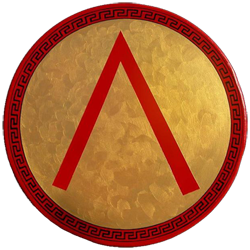
Sparta (Doric Greek: Σπάρτα, Spártā; Attic Greek: Σπάρτη, Spártē) was a prominent city-state in ancient Greece. In antiquity the city-state was known as Lacedaemon (Λακεδαίμων, Lakedaímōn), while the name Sparta referred to its main settlement on the banks of the Eurotas River in Laconia, in south-eastern Peloponnese.[1] Around 650 BC, it rose to become the dominant military land-power in ancient Greece.
Given its military pre-eminence, Sparta was recognized as the overall leader of the combined Greek forces during the Greco-Persian Wars.[2] Between 431 and 404 BC, Sparta was the principal enemy of Athens during the Peloponnesian War,[3] from which it emerged victorious, though at a great cost of lives lost. Sparta's defeat by Thebes in the Battle of Leuctra in 371 BC ended Sparta's prominent role in Greece. However, it maintained its political independence until the Roman conquest of Greece in 146 BC. It then underwent a long period of decline, especially in the Middle Ages, when many Spartans moved to live in Mystras. Modern Sparta is the capital of the Greek regional unit of Laconia and a center for the processing of goods such as citrus and olives.
Sparta was unique in ancient Greece for its social system and constitution, which configured their entire society to maximize military proficiency at all costs, and completely focused on military training and excellence. Its inhabitants were classified as Spartiates (Spartan citizens, who enjoyed full rights), mothakes (non-Spartan free men raised as Spartans), perioikoi (free residents, literally "dwellers around"), and helots (state-owned serfs, enslaved non-Spartan local population). Spartiates underwent the rigorous agoge training and education regimen, and Spartan phalanges were widely considered to be among the best in battle. Spartan women enjoyed considerably more rights and equality to men than elsewhere in the classical antiquity.
Sparta was the subject of fascination in its own day, as well as in Western culture following the revival of classical learning.[n 1] This love or admiration of Sparta is known as Laconism or Laconophilia. At its peak around 500 BC the size of the city would have been some 20,000–35,000 citizens, plus numerous helots and perioikoi. The likely total of 40,000–50,000 made Sparta one of the largest Greek cities;[4][5] however, according to Thucydides, the population of Athens in 431 BC was 360,000–610,000, making it unlikely that Athens was smaller than Sparta in 5th century BC.[n 2] The French classicist François Ollier in his 1933 book Le mirage spartiate ("The Spartan Mirage") warned that a major scholarly problem regarding Sparta is that all the surviving accounts were written by non-Spartans who often presented an excessively idealized image of Sparta.[7] Ollier's views have been widely accepted by scholars.[7]
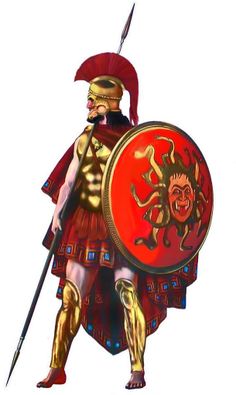
Geography
Sparta is located in the region of Laconia, in the south-eastern Peloponnese. Ancient Sparta was built on the banks of the Eurotas River, the main river of Laconia, which provided it with a source of fresh water. The valley of the Eurotas is a natural fortress, bounded to the west by Mt. Taygetus (2,407 m) and to the east by Mt. Parnon (1,935 m). To the north, Laconia is separated from Arcadia by hilly uplands reaching 1000 m in altitude. These natural defenses worked to Sparta's advantage and contributed to Sparta never having been sacked. Though landlocked, Sparta had a harbor, Gytheio, on the Laconian Gulf.
History
Prehistory, "dark age" and archaic period
The prehistory of Sparta is difficult to reconstruct because the literary evidence is far removed in time from the events it describes and is also distorted by oral tradition.[29] However, the earliest certain evidence of human settlement in the region of Sparta consists of pottery dating from the Middle Neolithic period, found in the vicinity of Kouphovouno some two kilometres (1.2 miles) south-southwest of Sparta.[30] These are the earliest traces of the original Mycenaean Spartan civilisation, as represented in Homer's Iliad.[citation needed]
This civilization seems to have fallen into decline by the late Bronze Age, when, according to Herodotus, Macedonian tribes from the north (called Dorians by those they conquered) marched into Peloponnese and, subjugating the local tribes, settled there.[29] The Dorians seem to have set about expanding the frontiers of Spartan territory almost before they had established their own state.[31] They fought against the Argive Dorians to the east and southeast, and also the Arcadian Achaeans to the northwest. The evidence suggests that Sparta, relatively inaccessible because of the topography of the Taygetan plain, was secure from early on: it was never fortified.[31]
Nothing distinctive in the archaeology of the Eurotas River Valley identifies the Dorians or the Dorian Spartan state. The prehistory of the Neolithic, the Bronze Age and the Dark Age (the Early Iron Age) at this moment must be treated apart from the stream of Dorian Spartan history.
The legendary period of Spartan history is believed to fall into the Dark Age. It treats the mythic heroes such as the Heraclids and the Perseids, offering a view of the occupation of the Peloponnesus that contains both fantastic and possibly historical elements. The subsequent proto-historic period, combining both legend and historical fragments, offers the first credible history.
Between the 8th and 7th centuries BC the Spartans experienced a period of lawlessness and civil strife, later attested by both Herodotus and Thucydides.[32] As a result, they carried out a series of political and social reforms of their own society which they later attributed to a semi-mythical lawgiver, Lycurgus.[33] These reforms mark the beginning of the history of Classical Sparta.
Classical Sparta
In the Second Messenian War, Sparta established itself as a local power in Peloponnesus and the rest of Greece. During the following centuries, Sparta's reputation as a land-fighting force was unequalled.[34] In 480 BC a small force of Spartans, Thespians, and Thebans led by King Leonidas (approximately 300 were full Spartiates, 700 were Thespians, and 400 were Thebans although these numbers do not reflect casualties incurred prior to the final battle), made a legendary last stand at the Battle of Thermopylae against the massive Persian army, inflicting very high casualties on the Persian forces before finally being encircled.[35] The superior weaponry, strategy, and bronze armour of the Greek hoplites and their phalanx again proved their worth one year later when Sparta assembled at full strength and led a Greek alliance against the Persians at the battle of Plataea.
The decisive Greek victory at Plataea put an end to the Greco-Persian War along with Persian ambition of expanding into Europe. Even though this war was won by a pan-Greek army, credit was given to Sparta, who besides being the protagonist at Thermopylae and Plataea, had been the de facto leader of the entire Greek expedition.[36]
In later Classical times, Sparta along with Athens, Thebes, and Persia had been the main powers fighting for supremacy against each other. As a result of the Peloponnesian War, Sparta, a traditionally continental culture, became a naval power. At the peak of its power Sparta subdued many of the key Greek states and even managed to overpower the elite Athenian navy. By the end of the 5th century BC it stood out as a state which had defeated the Athenian Empire and had invaded the Persian provinces in Anatolia, a period which marks the Spartan Hegemony.
During the Corinthian War Sparta faced a coalition of the leading Greek states: Thebes, Athens, Corinth, and Argos. The alliance was initially backed by Persia, whose lands in Anatolia had been invaded by Sparta and which feared further Spartan expansion into Asia.[37] Sparta achieved a series of land victories, but many of her ships were destroyed at the battle of Cnidus by a Greek-Phoenician mercenary fleet that Persia had provided to Athens. The event severely damaged Sparta's naval power but did not end its aspirations of invading further into Persia, until Conon the Athenian ravaged the Spartan coastline and provoked the old Spartan fear of a helot revolt.[38]
After a few more years of fighting, in 387 BC the Peace of Antalcidas was established, according to which all Greek cities of Ionia would return to Persian control, and Persia's Asian border would be free of the Spartan threat.[38] The effects of the war were to reaffirm Persia's ability to interfere successfully in Greek politics and to affirm Sparta's weakened hegemonic position in the Greek political system.[39] Sparta entered its long-term decline after a severe military defeat to Epaminondas of Thebes at the Battle of Leuctra. This was the first time that a Spartan army lost a land battle at full strength.
As Spartan citizenship was inherited by blood, Sparta now increasingly faced a helot population that vastly outnumbered its citizens. The alarming decline of Spartan citizens was commented on by Aristotle.
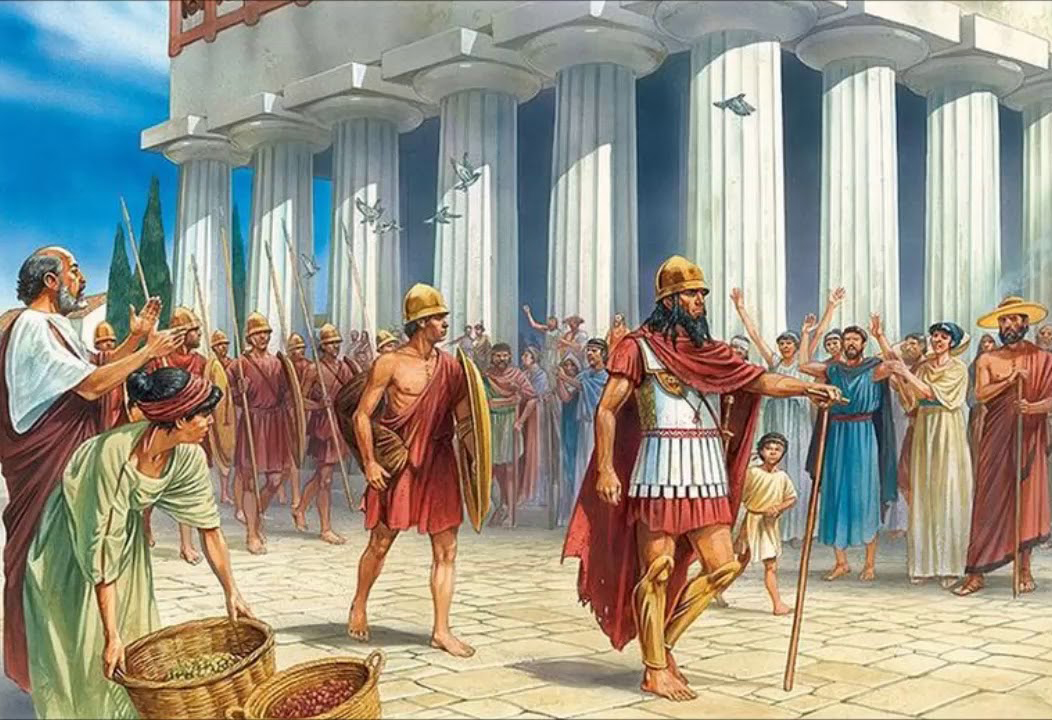
Hellenistic and Roman Sparta
Sparta never fully recovered from the losses that the Spartans suffered at Leuctra in 371 BC and the subsequent helot revolts. Nonetheless, it was able to continue as a regional power for over two centuries. Neither Philip II nor his son Alexander the Great attempted to conquer Sparta itself.
Even during its decline, Sparta never forgot its claim to be the "defender of Hellenism" and its Laconic wit. An anecdote has it that when Philip II sent a message to Sparta saying "If I enter Laconia, I will raze Sparta", the Spartans responded with the single, terse reply: "if".[40][41][42]
When Philip created the league of the Greeks on the pretext of unifying Greece against Persia, the Spartans chose not to join, since they had no interest in joining a pan-Greek expedition unless it were under Spartan leadership. Thus, upon defeating the Persians at the Battle of the Granicus, Alexander the Great sent to Athens 300 suits of Persian armour with the following inscription: "Alexander, son of Philip, and all the Greeks except the Spartans, give these offerings taken from the foreigners who live in Asia".
During Alexander's campaigns in the east, the Spartan king, Agis III sent a force to Crete in 333 BC with the aim of securing the island for Sparta.[43] Agis next took command of allied Greek forces against Macedon, gaining early successes, before laying siege to Megalopolis in 331 BC. A large Macedonian army under general Antipater marched to its relief and defeated the Spartan-led force in a pitched battle.[44] More than 5,300 of the Spartans and their allies were killed in battle, and 3,500 of Antipater's troops.[45] Agis, now wounded and unable to stand, ordered his men to leave him behind to face the advancing Macedonian army so that he could buy them time to retreat. On his knees, the Spartan king slew several enemy soldiers before being finally killed by a javelin.[46] Alexander was merciful, and he only forced the Spartans to join the League of Corinth, which they had previously refused to join.[47]
During the Punic Wars Sparta was an ally of the Roman Republic. Spartan political independence was put to an end when it was eventually forced into the Achaean League after its defeat in the decisive Laconian War by a coalition of other Greek city-states and Rome and the resultant overthrow of its final king Nabis. Sparta played no active part in the Achaean War in 146 BC when the Achaean League was defeated by the Roman general Lucius Mummius. Subsequently, Sparta become a free city in the Roman sense, some of the institutions of Lycurgus were restored[48] and the city became a tourist attraction for the Roman elite who came to observe exotic Spartan customs.[n 4]
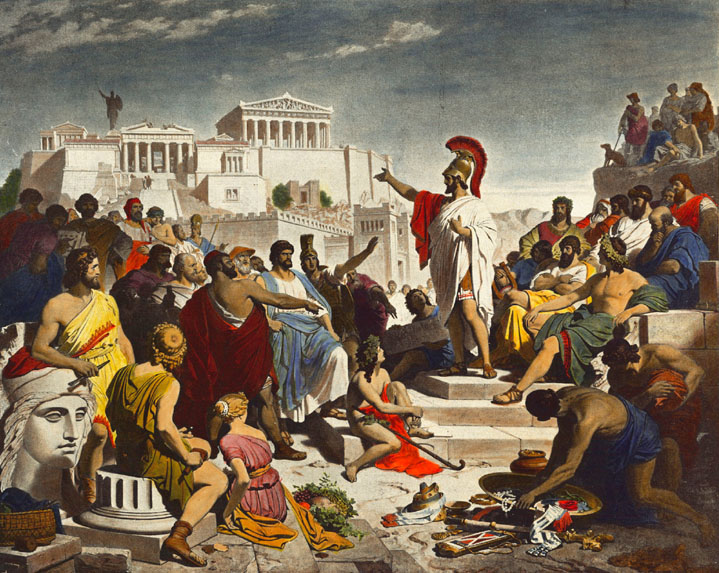
Postclassical and modern Sparta
According to Byzantine sources, some parts of the Laconian region remained pagan until well into the 10th century AD. Doric-speaking populations survive today in Tsakonia. In the Middle Ages, the political and cultural center of Laconia shifted to the nearby settlement of Mystras, and Sparta fell further in even local importance. Modern Sparti was re-founded in 1834, by a decree of King Otto of Greece.
Spartan Society

Constitution
Sparta was an oligarchy. The state was ruled by two hereditary kings of the Agiad and Eurypontid families,[51] both supposedly descendants of Heracles and equal in authority, so that one could not act against the power and political enactments of his colleague.[25]
The duties of the kings were primarily religious, judicial, and military. They were the chief priests of the state and also maintained communication with the Delphian sanctuary, which always exercised great authority in Spartan politics. In the time of Herodotus, about 450 BC, their judicial functions had been restricted to cases dealing with heiresses, adoptions and the public roads. Aristotle describes the kingship at Sparta as "a kind of unlimited and perpetual generalship" (Pol. iii. 1285a), while Isocrates refers to the Spartans as "subject to an oligarchy at home, to a kingship on campaign" (iii. 24).[25]
Civil and criminal cases were decided by a group of officials known as the ephors, as well as a council of elders known as the gerousia. The gerousia consisted of 28 elders over the age of 60, elected for life and usually part of the royal households, and the two kings.[52] High state policy decisions were discussed by this council who could then propose action alternatives to the damos, the collective body of Spartan citizenry, who would select one of the alternatives by voting.[53][54]
The royal prerogatives were curtailed over time. Dating from the period of the Persian wars, the king lost the right to declare war and was accompanied in the field by two ephors. He was supplanted also by the ephors in the control of foreign policy. Over time, the kings became mere figureheads except in their capacity as generals. Real power was transferred to the ephors and to the gerousia.[25]
The origins of the powers exercised by the assembly of the citizens called the Apella are virtually unknown because of the lack of historical documentation[25] and Spartan state secrecy.
Citizenship
Not all inhabitants of the Spartan state were considered to be citizens. Only those who had undertaken the Spartan education process known as the agoge were eligible. However, usually the only people eligible to receive the agoge were Spartiates, or people who could trace their ancestry to the original inhabitants of the city.
There were two exceptions. Trophimoi or "foster sons" were foreign students invited to study. The Athenian general Xenophon, for example, sent his two sons to Sparta as trophimoi. The other exception was that the son of a helot could be enrolled as a syntrophos[55] if a Spartiate formally adopted him and paid his way. If a syntrophos did exceptionally well in training, he might be sponsored to become a Spartiate.[56] Spartans who could not afford to pay the expenses of the agoge could lose their citizenship.
These laws meant that Sparta could not readily replace citizens lost in battle or otherwise and eventually proved near fatal to the continuance of the state as the number of citizens became greatly outnumbered by the non-citizens and, even more dangerously, the helots.
Non citizens
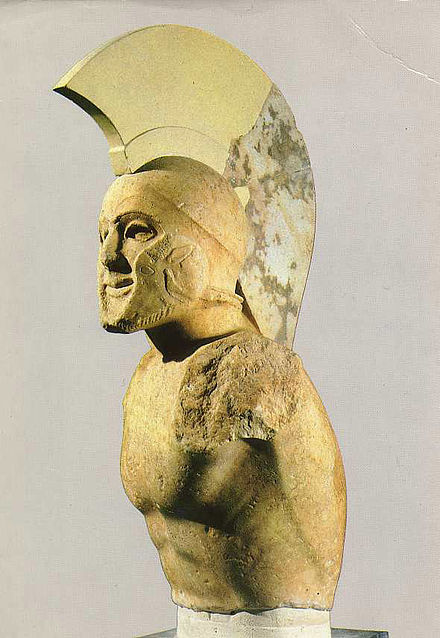
Others in the state were the perioikoi, who were free inhabitants of Spartan territory but were non-citizens, and the helots,[57] the state-owned serfs. Descendants of non-Spartan citizens were not able to follow the agoge.
Helots
The Spartans were a minority of the Lakonian population. The largest class of inhabitants were the helots (in Classical Greek Εἵλωτες / Heílôtes).[58][59]
The helots were originally free Greeks from the areas of Messenia and Lakonia whom the Spartans had defeated in battle and subsequently enslaved. In contrast to populations conquered by other Greek cities (e.g. the Athenian treatment of Melos), the male population was not exterminated and the women and children turned into chattel slaves. Instead, the helots were given a subordinate position in society more comparable to serfs in medieval Europe than chattel slaves in the rest of Greece.
Helots did not have voting rights, although compared to non-Greek chattel slaves in other parts of Greece they were relatively privileged. The Spartan poet Tyrtaios refers to Helots being allowed to marry and retaining 50% of the fruits of their labor.[60] They also seem to have been allowed to practice religious rites and, according to Thucydides, own a limited amount of personal property.[61] Some 6,000 helots accumulated enough wealth to buy their freedom, for example, in 227 BC.
In other Greek city-states, free citizens were part-time soldiers who, when not at war, carried on other trades. Since Spartan men were full-time soldiers, they were not available to carry out manual labour.[62] The helots were used as unskilled serfs, tilling Spartan land. Helot women were often used as wet nurses. Helots also travelled with the Spartan army as non-combatant serfs. At the last stand of the Battle of Thermopylae, the Greek dead included not just the legendary three hundred Spartan soldiers but also several hundred Thespian and Theban troops and a number of helots.[63]
Relations between the helots and their Spartan masters were sometimes strained. There was at least one helot revolt (ca. 465–460 BC), and Thucydides remarked that "Spartan policy is always mainly governed by the necessity of taking precautions against the helots."[64][65] On the other hand, the Spartans trusted their helots enough in 479 BC to take a force of 35,000 with them to Plataea, something they could not have risked if they feared the helots would attack them or run away. Slave revolts occurred elsewhere in the Greek world, and in 413 BC 20,000 Athenian slaves ran away to join the Spartan forces occupying Attica.[66] What made Sparta's relations with her slave population unique was that the helots, precisely because they enjoyed privileges such as family and property, retained their identity as a conquered people (the Messenians) and also had effective kinship groups that could be used to organize rebellion.
As the Spartiate population declined and the helot population continued to grow, the imbalance of power caused increasing tension. According to Myron of Priene[67] of the middle 3rd century BC:
"They assign to the Helots every shameful task leading to disgrace. For they ordained that each one of them must wear a dogskin cap (κυνῆ / kunễ) and wrap himself in skins (διφθέρα / diphthéra) and receive a stipulated number of beatings every year regardless of any wrongdoing, so that they would never forget they were slaves. Moreover, if any exceeded the vigour proper to a slave's condition, they made death the penalty; and they allotted a punishment to those controlling them if they failed to rebuke those who were growing fat".[68]
Plutarch also states that Spartans treated the Helots "harshly and cruelly": they compelled them to drink pure wine (which was considered dangerous – wine usually being cut with water) "...and to lead them in that condition into their public halls, that the children might see what a sight a drunken man is; they made them to dance low dances, and sing ridiculous songs..." during syssitia (obligatory banquets).[69]
Each year when the Ephors took office they ritually declared war on the helots, thereby allowing Spartans to kill them without the risk of ritual pollution.[70] This seems to have been done by kryptai (sing. κρύπτης kryptēs), graduates of the agoge who took part in the mysterious institution known as the Krypteia.[71] Thucydides states:
"The helots were invited by a proclamation to pick out those of their number who claimed to have most distinguished themselves against the enemy, in order that they might receive their freedom; the object being to test them, as it was thought that the first to claim their freedom would be the most high spirited and the most apt to rebel. As many as two thousand were selected accordingly, who crowned themselves and went round the temples, rejoicing in their new freedom. The Spartans, however, soon afterwards did away with them, and no one ever knew how each of them perished."[72][73]
Perioikoi
The Perioikoi came from similar origins as the helots but occupied a significantly different position in Spartan society. Although they did not enjoy full citizen-rights, they were free and not subjected to the same restrictions as the helots. The exact nature of their subjection to the Spartans is not clear, but they seem to have served partly as a kind of military reserve, partly as skilled craftsmen and partly as agents of foreign trade.[74] Perioikoic hoplites served increasingly with the Spartan army, explicitly at the Battle of Plataea, and although they may also have fulfilled functions such as the manufacture and repair of armour and weapons,[75] they were increasingly integrated into the combat units of the Spartan army as the Spartiate population declined.[76]
Economy
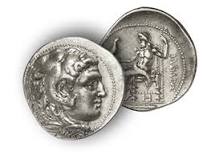
Spartan citizens were debarred by law from trade or manufacture, which consequently rested in the hands of the Perioikoi.[25] The Periokoi monopoly on trade and manufacturing in one of the richest territories of Greece explains in large part the loyalty of the perioikoi to the Spartan state. Lacedaemon was rich in natural resources, fertile and blessed with a number of good natural harbors. The periokoi could exploit these resources for their own enrichment, and did.[77]
Spartiates, on the other hand, were forbidden (in theory) from engaging in menial labor or trade, although there is evidence of Spartan sculptors,[78] and Spartans were certainly poets, magistrates, ambassadors, and governors as well as soldiers. Allegedly, Spartans were prohibited from possessing gold and silver coins, and according to legend Spartan currency consisted of iron bars to discourage hoarding.[79][80] It was not until the 260s or 250s BC that Sparta began to mint its own coins.[81]
The conspicuous display of wealth appears to have been discouraged, although this did not preclude the production of very fine, highly decorated bronze, ivory and wooden works of art and the production of jewellery. Archeology has produced many examples of all these objects, some of which are exquisite.[82]
Allegedly in connection with the Lycurgan Reforms (e.g. in the mid-8th Century BC), property had been divided into 9,000 equal portions as part of a massive land reform. Each citizen received one estate, a kleros, and thereafter was expected to derive his wealth from it.[83] The land itself was worked by helots, who retained half the yield. From the other half, the Spartiate was expected to pay his mess (syssitia) fees, and the agoge fees for his children. However, we know nothing about whether land could be bought and sold, whether it could be inherited, if so by what system (primogeniture or equally divided among heirs), whether daughters received dowries and much more.[84] What is clear is that from early on there were marked differences of wealth within the state, and these became even more serious after the law of Epitadeus, passed at some time after the Peloponnesian War, removed the legal prohibition of the gift or bequest of land.[25][85] By the mid-5th century, land had become concentrated in the hands of a tiny elite, and the notion of all Spartan citizens being "equals" had become a farce. By Aristotle's day (384–322 BC) citizenship had been reduced from 9,000 to less than 1,000, and then further decreased to 700 at the accession of Agis IV in 244 BC. Attempts were made to remedy this situation by creating new laws. Certain penalties were imposed upon those who remained unmarried or who married too late in life.[25] These laws, however, came too late and were ineffective in reversing the trend.
Life in Classical Sparta
Birth and Death
Sparta was above all a militarist state, and emphasis on military fitness began virtually at birth. Shortly after birth, a mother would bathe her child in wine to see whether the child was strong. If the child survived it was brought before the Gerousia by the child's father. The Gerousia then decided whether it was to be reared or not.[25] It is commonly stated that if they considered it "puny and deformed", the baby was thrown into a chasm on Mount Taygetos known euphemistically as the Apothetae (Gr., ἀποθέται, "Deposits").[86][87] This was, in effect, a primitive form of eugenics.[86] Sparta is often portrayed as being unique in this matter; however, there is considerable evidence that the killing of unwanted children was practiced in other Greek regions, including Athens.[88] There is controversy about the matter in Sparta, since excavations in the chasm only uncovered adult remains, likely belonging to criminals.[89]
When Spartans died, marked headstones would only be granted to soldiers who died in combat during a victorious campaign or women who died either in service of a divine office or in childbirth.[90]
Education
When male Spartans began military training at age seven, they would enter the agoge system. The agoge was designed to encourage discipline and physical toughness and to emphasize the importance of the Spartan state. Boys lived in communal messes and, according to Xenophon, whose sons attended the agoge, the boys were fed "just the right amount for them never to become sluggish through being too full, while also giving them a taste of what it is not to have enough."[91] In addition they were trained to survive in times of privation, even if it meant stealing.[92] Besides physical and weapons training, boys studied reading, writing, music and dancing. Special punishments were imposed if boys failed to answer questions sufficiently 'laconically' (i.e. briefly and wittily).[93]
There is some evidence that in late-Classical and Hellenistic Sparta boys were expected to take an older male mentor, usually an unmarried young man. However, there is no evidence of this in archaic Sparta. According to some sources, the older man was expected to function as a kind of substitute father and role model to his junior partner; however, others believe it was reasonably certain that they had sexual relations (the exact nature of Spartan pederasty is not entirely clear).[94] It is notable, however, that the only contemporary source with direct experience of the agoge, Xenophon, explicitly denies the sexual nature of the relationship.[91]
Post 465 BC, some Spartan youth apparently became members of an irregular unit known as the Krypteia. The immediate objective of this unit was to seek out and kill vulnerable helot Laconians as part of the larger program of terrorising and intimidating the helot population.[95]
Less information is available about the education of Spartan girls, but they seem to have gone through a fairly extensive formal educational cycle, broadly similar to that of the boys but with less emphasis on military training. In this respect, classical Sparta was unique in ancient Greece. In no other city-state did women receive any kind of formal education.[96]
Military Life

At age 20, the Spartan citizen began his membership in one of the syssitia (dining messes or clubs), composed of about fifteen members each, of which every citizen was required to be a member.[25] Here each group learned how to bond and rely on one another. The Spartans were not eligible for election for public office until the age of 30. Only native Spartans were considered full citizens and were obliged to undergo the training as prescribed by law, as well as participate in and contribute financially to one of the syssitia.[97]
Sparta is thought to be the first city to practice athletic nudity, and some scholars claim that it was also the first to formalize pederasty.[98] According to these sources, the Spartans believed that the love of an older, accomplished aristocrat for an adolescent was essential to his formation as a free citizen. The agoge, the education of the ruling class, was, they claim, founded on pederastic relationships required of each citizen,[99] with the lover responsible for the boy's training.
However, other scholars question this interpretation. Xenophon explicitly denies it,[91] but not Plutarch.[100]
Spartan men remained in the active reserve until age 60. Men were encouraged to marry at age 20 but could not live with their families until they left their active military service at age 30. They called themselves "homoioi" (equals), pointing to their common lifestyle and the discipline of the phalanx, which demanded that no soldier be superior to his comrades.[101] Insofar as hoplite warfare could be perfected, the Spartans did so.[102]
Thucydides reports that when a Spartan man went to war, his wife (or another woman of some significance) would customarily present him with his hoplon (shield) and say: "With this, or upon this" (Ἢ τὰν ἢ ἐπὶ τᾶς, Èi tàn èi èpì tàs), meaning that true Spartans could only return to Sparta either victorious (with their shield in hand) or dead (carried upon it).[103] Unfortunately, poignant as this image may be, it is almost certainly propaganda. Spartans buried their battle dead on or near the battle field; corpses were not brought back on their hoplons.[104] Nevertheless, it is fair to say that it was less of a disgrace for a soldier to lose his helmet, breastplate or greaves than his hoplon, since the former were designed to protect one man, whereas the hoplon also protected the man on his left. Thus the shield was symbolic of the individual soldier's subordination to his unit, his integral part in its success, and his solemn responsibility to his comrades in arms – messmates and friends, often close blood relations.
According to Aristotle, the Spartan military culture was actually short-sighted and ineffective. He observed:
It is the standards of civilized men not of beasts that must be kept in mind, for it is good men not beasts who are capable of real courage. Those like the Spartans who concentrate on the one and ignore the other in their education turn men into machines and in devoting themselves to one single aspect of city's life, end up making them inferior even in that.[105]
Aristotle was a harsh critic of the Spartan constitution and way of life. There is considerable evidence that the Spartans, certainly in the archaic period, were not educated as one-sidedly as Aristotle asserts. In fact, the Spartans were also rigorously trained in logic and philosophy.[106]
One of the most persistent myths about Sparta that has no basis in fact is the notion that Spartan mothers were without feelings toward their off-spring and helped enforce a militaristic lifestyle on their sons and husbands.[107][108] The myth can be traced back to Plutarch, who includes no less than 17 "sayings" of "Spartan women," all of which paraphrase or elaborate on the theme that Spartan mothers rejected their own offspring if they showed any kind of cowardice. In some of these sayings, mothers revile their sons in insulting language merely for surviving a battle. These sayings purporting to be from Spartan women were far more likely to be of Athenian origin and designed to portray Spartan women as unnatural and so undeserving of pity.[104]
Agriculture, Food, and Diet
Sparta's agriculture consisted mainly of barley, wine, cheese, grain, and figs. These items were grown locally on each Spartan citizens kleros and were tended to by helots. Spartan citizens were required to donate a certain amount of what they yielded from their kleros to their syssitia, or mess. These donations to the syssitia were a requirement for every Spartan citizen. All the donated food was then redistributed to feed the Spartan population of that syssitia.[109] The helots who tended to the lands were fed using a portion of what they harvested.[110]
Agriculture, Food, and Diet
Sparta's agriculture consisted mainly of barley, wine, cheese, grain, and figs. These items were grown locally on each Spartan citizens kleros and were tended to by helots. Spartan citizens were required to donate a certain amount of what they yielded from their kleros to their syssitia, or mess. These donations to the syssitia were a requirement for every Spartan citizen. All the donated food was then redistributed to feed the Spartan population of that syssitia.[109] The helots who tended to the lands were fed using a portion of what they harvested.[110]
Marrige
Plutarch reports the peculiar customs associated with the Spartan wedding night:
The custom was to capture women for marriage(...) The so-called 'bridesmaid' took charge of the captured girl. She first shaved her head to the scalp, then dressed her in a man's cloak and sandals, and laid her down alone on a mattress in the dark. The bridegroom – who was not drunk and thus not impotent, but was sober as always – first had dinner in the messes, then would slip in, undo her belt, lift her and carry her to the bed.[111]
The husband continued to visit his wife in secret for some time after the marriage. These customs, unique to the Spartans, have been interpreted in various ways. One of them decidedly supports the need to disguise the bride as a man in order to help the bridegroom consummate the marriage, so unaccustomed were men to women's looks at the time of their first intercourse. The "abduction" may have served to ward off the evil eye, and the cutting of the wife's hair was perhaps part of a rite of passage that signaled her entrance into a new life.[112]